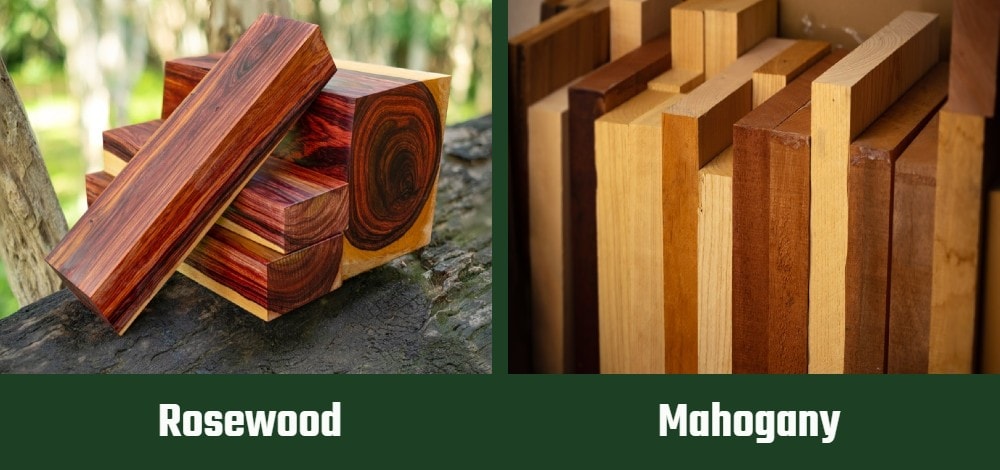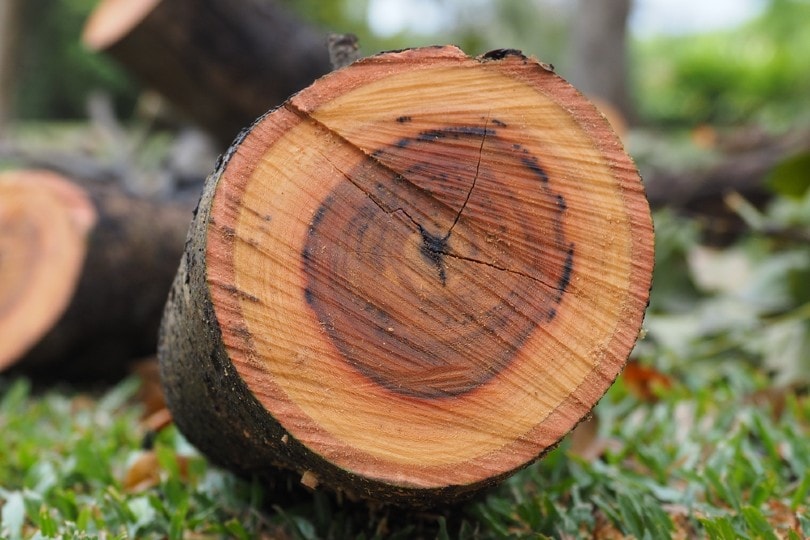Rosewood vs Mahogany: Pros, Cons, & Differences
-

- Last updated:

Wood is one of the oldest and most versatile building materials. It is been around for ages and is praised for its flexibility, longevity, and lovely natural colors and textures. Now, both rosewood and mahogany are a go-to choice for commercial and DIY work, including flooring, carving, and musical instruments. So, which timber will be best for your new project?
These hardwood species have lots in common, yet they’re very much different. To help you with the choice, we’ll take a close look at their properties, common uses, pros, and cons. We’ll also cover the similarities, pricing, and come up with a verdict. If you’ve been having a hard time trying to pick between these beautiful, richly hued premium wood types, this guide is for you!

Rosewood
This term is used to describe a wide range of timbers. The most popular types include the Brazilian, Indian, and Madagascar rosewoods. What makes all rosewoods special are the textures, rings, and patterns. The unique coloring, resilient yet resistant nature, and extended lifespan (compared to most hardwoods) turn these wood species into one of the most commonly used luxury materials out there. Here’s a quick look at their characteristics, common uses, and workability.

Key Properties and Characteristics
All rosewoods are sturdy and durable with an above-average Janka rating. Plus, they have their own distinctive features. For example, the Brazilian species is known for its unique smell that lingers for many years. It is incredibly heavy and hard (2,700 pounds on the Janka list) and ranges from red to dark brown. On top of that, it’s very strong against pests. The Indian rosewood, in turn, has a long, straight bore, above-average density, and strength.
And what about the Madagascar rosewood—what does it have to offer? Its biggest selling point is the deep purple color. It is quite similar to that of the Brazilian rosewood but looks more “expensive”. So, if you want your furniture, flooring, or any wooden accessories to instantly stand out, the Madagascar rosewood will be a great pick. Just like the Brazilian rosewood, it’s harder than most woods (2,700 pounds).
Is Rosewood Easy to Work With?
This is a “true” hardwood. It’s harder than most wood types, and that makes it a bit tricky to work with. It’s fairly pliable but not too flexible. As a general rule, the harder the wood, the more effort it takes to handle it. Now, rosewood is used for carving and making musical instruments. That automatically means it’s more than manageable. It’s just that you’ll need experience and the right tools to shape it to your liking.
Also, this wood is quite heavy. For some applications (like building cabinets or covering the floor), this is good news. But, again, for delicate work, it’s a bit rough. Rosewoods have quite a wide color range that goes from red to ebony, though, which compensates for the tough-to-master nature.
The Best Uses for Rosewood
In contrast to most hardwoods, rosewood isn’t only good for flooring: it has many different applications. Fountain pens, billiard cues, and even chess pieces are also crafted from this wood. The Brazilian rosewood is praised for its remarkable acoustic resonance—a bright, clear, metallic ring with lots of overtones, perfect for a musical instrument like a steel or classic guitar. It’s arguably the best-sounding material for guitar sides and backs.
Next, the Indian rosewood is mostly used for guitar bodies, bridges, and fretboards. And it is a premium-quality material for cabinetry and flooring. The same is true for furniture, including cabinets, chairs, and couches. It is naturally protected against humidity and other elements, which is why you’ll often see expensive boats crafted from Indian rosewood. Finally, the Madagascar rosewood is used for turned objects, carving, and, again, cabinetry and furniture, along with guitar bodies/boards.
- Has a clear, bright, distinct tone
- Perfect for guitar sides and backs
- A go-to choice for acoustic guitars
- Impressive hardness/durability
- Quite heavy for hardwood
- A bit on the expensive side
Mahogany
Much like rosewood, mahogany is presented by three different species: the big-leaf (strong and impact-resistant), West Indian (great for interior decoration and guitars), and the Swietenia humilis (used for making furniture) mahogany. Native to the Americas, this is straight-grained timber, mostly used for paneling, making boats, cabinetry, flooring, and musical instruments. Is this a dense wood type, though? What can you use it for? Let’s talk about that next.

Key Properties and Characteristics
While most hardwoods are light brown, mahogany has a reddish tone that instantly grabs attention. In this regard, it looks a lot like walnut, but mahogany has a subtle grain and lush texture that sets it apart from all the other hardwoods. Just like rosewood, this is a premium hardwood species. On top of that, mahogany is incredibly flexible and versatile.
It’s not the hardest wood type out there, that’s true (it has a Janka rating of 900 pounds), yet it’s still quite hard and dent-resistant. Wood density is higher than the industry average (56 lb/ft3). And what about resistance to elements? Mahogany is very strong against rot and decay—you won’t have to worry about high humidity levels affecting it in the long run. That’s why it’s used for outdoor decking.
Is Mahogany Easy to Work With?
The short answer is yes, it’s more flexible than rosewood. The reason: rosewood is two times harder. As a result, mahogany takes less sleight of hands and only some basic tools to get started. The excellent workability is one of the reasons why it’s so popular. Thus, if you’re new to DIY wood crafting and want to start with luxury hardwood, mahogany will be a great pick. A quick note: mahogany isn’t very loud (we’re talking about acoustics). This isn’t a defect, just a natural feature.

The Best Uses for Mahogany
It’s safe to say that this is one of the most easily recognized wood types for kitchen cabinets, especially here in the US. It stains well, doesn’t take much effort to paint over, and looks great in any environment. You can even use it in the bathroom, thanks to the above-average resistance to decay. You can use it for flooring, too. While that won’t be cheap, it will be a worthy investment in the long run. Mahogany doesn’t scratch easily and lasts for many years if not decades.
Is it a good choice for musical instruments? Absolutely! Mahogany is the most commonly used wood type for instruments. It has similar characteristics to rosewood but features a more balanced, warmer tone. Is mahogany better than rosemary? Not necessarily. It all comes down to the acoustic properties that you’re looking for. As a tonewood, it does have a unique sound that’s just right for electric guitar bodies and acoustic guitar sides and necks.
- Boasts a warm, resonating sound
- Practically immune to decay and rot
- A go-to choice for premium furniture
- Flexible, easy to work with
- Not particularly hard
- Could’ve been a bit louder
What Do Rosewood and Mahogany Have in Common?
This might be a bit surprising, but these two wood species have more in common than they are different. First, both mahogany and rosewood are hardwoods. Second, they have a very similar color or tone. As we learned earlier, the acoustic tones are different but of premium quality. The same is true for their applications (common uses). People that look for luxury flooring or cabinets always end up adding these hardwoods to the list.
Last but not least, the various mahogany and rosewood species are very strong against moisture, decay, bending, rotting, and pests. Yes, there are lots of shared characteristics and uses between these two, which is why many DIY fans tend to mistake them for one another. So, don’t hesitate to use this review/comparison as your guide when picking the hardwood for your project!
Is Mahogany More Expensive?
No, it’s actually the other way around: rosewood costs more than mahogany. The difference isn’t that big, as they’re both luxury hardwood timber, but it’s still there. Besides, if you want to buy rosewood cabinetry or use it for flooring in a big house, that will cost significantly more compared to mahogany. Rosewood is a rare species. Plus, it’s harder, denser, and has a slightly longer lifespan.
Also, due to its popularity, rosewood is near-extinct in some parts of the planet. This is especially true for the Brazilian species. International trade is limited, making it very hard to get your hands on it. Together, all these factors add up to a steeper price. The big-leaf and West Indian mahoganies are also at risk of going extinct, but they’re not nearly as endangered as rosewood.
What is the Right Option for You?
Alright, so, now that we’ve reviewed both hardwoods in great detail and checked out their pros and cons, which wood type is right for you? Should you go with rosewood, the hard, dense, and expensive option? Or maybe you’ll be better off with mahogany, its flexible, resistant, and not-that-hard counterpart? This depends on what your project is. If you’re building a musical instrument and want a warm tone, mahogany will be right up your alley.
But if you want that bright, crisp sound with lots of mid-range, rosewood will make sure you have that. And what about cabinets, flooring, and carving? Visually, both hardwoods are stunning (but rosewood has a better pattern and texture). Next, while mahogany and rosewood serve for a long time, rosewood has a more impressive lifespan. To counter that, mahogany is more “user-friendly” and will be a better choice if you’re a novice.
Again, we’re dealing with premium wood species here, but only you can decide which one to pick!
- You’re going for a loud, distinct tone
- Durability and longevity are a top priority
- You’re a fan of fingerstyle playing
- You’re ready to spend extra for quality
- You’re a fan of warm, blended tones
- You’re looking for a flexible hardwood
- Rhythm playing is what you’re after
- The project has a limited budget

Conclusion
Hardwoods are a long-time favorite in construction. They are reasonably priced, take very little effort in maintenance, and come in all shapes and sizes. As for rosewood and mahogany, they’re highly resistant to natural elements (humidity, decay, rot, and insects), look absolutely stunning on floors and cabinets, and are commonly used for building musical instruments.
If you’re a big fan of clear acoustic tones, fingerstyle, and durability, rosewood will be the preferred pick. Mahogany, in turn, excels at producing warmer tones and rhythm playing. Plus, it’s cheaper and more easily accessible. So, pick your hardwood type depending on the current project to get the best bang for the buck!
- The Wood Database – BRAZILIAN ROSEWOOD
- The Wood Database – MADAGASCAR ROSEWOOD
- Let’sTalkGuild – Rosewood vs mahogany?
- Yahama – A Brief Guide To Acoustic Guitar Tonewoods
- ArchitectureArtDesigns – Different Types of Wood Flooring
- Rosewood vs Mahogany Acoustic Guitars: The Differences
- Eu – Mahogany or Rosewood?
Featured Image Credit: (L) Thichaa, Shutterstock | (R) optimarc, Shutterstock
Contents

